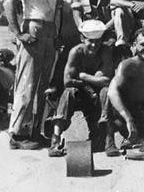HARRIS-CHARLES
CHARLES ALBERT "BUCKY" HARRIS

GM3

AN AMBUSH GOES AWRY
Charles Albert Harris was born on September 28, 1922, in Watertown, Massachusetts. Little has been recorded concerning his Navy career except for his service as a Gunners Mate Third Class crewmember on Motor Torpedo Boat USS PT-109. He reportedly was an original member of the crew when LTJG John Fitzgerald Kennedy, future U.S. President, became its Commanding Officer. Harris was known among the crew as “Bucky,” after a manager of the Boston Red Sox baseball team.
In Blackett Strait, south of Kolombangara in the Solomon Islands, the starless, moonless night of August 1-2, 1943, was profoundly dark, inky blackness. USS PT-109 stood at her station, one of fifteen PT boats that had set out to engage the well-known "Tokyo Express," the Japanese navy's supply convoy to soldiers fighting the advance of U.S. forces in the islands farther south. When the patrol came in contact with the Tokyo Express—three Japanese destroyers acting as transports with a fourth serving as escort—the encounter did not go well. Thirty torpedoes were fired without damaging the Japanese ships. Boats that had used up their complement of torpedoes were ordered home. The few that still had torpedoes remained in the strait for another try. What then transpired may well be the most famous small-craft engagement in U.S. naval history and surely the only time a vessel skippered by a future American President would be sunk in a collision with a Japanese ship.
PT-109 was one of the boats left behind. The boat’s commander, LTJG John Fitzgerald Kennedy rendezvoused his boat with two others. The three boats spread out to make a picket line across the strait. Unfortunately, none of the three PT boats was equipped with radar. At about 2:30 in the morning, a shape loomed out of the black darkness about three hundred yards off PT-109's starboard bow. Kennedy and his crew first saw a luminous wake and believed it was another PT boat. When it became apparent that it was a Japanese destroyer, Kennedy attempted to turn to starboard to bring his torpedoes to bear but there was not enough time. The Japanese destroyer, later identified as the AMAGIRI, had begun a 400-mile high speed run for Rabaul when a lookout spotted something small dead ahead. Correctly believing the unidentified boat to be an American PT boat the AMAGIRI’s commanding officer ordered the helmsman to speed directly toward the object. PT-109 was struck by AMAGIRI just forward of the forward starboard torpedo tube, ripping away the starboard aft side of the boat. Most of the crew were knocked into the water. The one man below decks miraculously escaped, although he was badly burned by exploding fuel. PT-109 had been sliced in half and the aft portion of the boat quickly sank.
GM3 Harris was reportedly asleep on deck at the time of the collusion and was one of the crewmembers knocked overboard. Fortunately, Harris was wearing his life jacket which he said he had instinctively thrown on as the collision occurred. Although the bow portion of the boat was floating, the surrounding water was largely covered with burning fuel. Harris suffered a bad wound on his left leg and his first thought as he found himself in the water battling the flames was that he was the only survivor. However, he soon heard the voice of the shipmate who had been badly burned. They then heard the voice of LTJG Kennedy and shouted in reply. Calling out intermittently, and Harris answering, Kennedy found them in the dark. Kennedy then towed the badly burned crewman to the bow portion of the boat by clutching the man’s life jacket strap in his teeth. GM3 Harris was struggling to swim so Kennedy returned to help him. Harris reportedly told Kennedy he was too tired to swim to which Kennedy is alleged to have said, “For a guy from Boston, you’re certainly putting up a great exhibition out here.” Their problem was solved when Harris asked Kennedy to hold him up while he took off his life jacket and the heavy sweater and boots that were dragging him down. That made it much easier and Harris was then able to swim to the remains of PT-109.
The crew took stock and discovered that two crewmembers had disappeared in the collision, very likely killed at impact. There was no sign of other boats or ships in the area and the men were afraid to fire their flare gun for fear of attracting the attention of the Japanese who were on islands on all sides. Although the wreckage was still afloat, it was taking on water and it capsized on the morning of August 2. After a discussion of options, the men abandoned the remains of PT-109 which was slowly sinking and started swimming for an islet nearby.
After a swim lasting about four hours, the survivors managed to reach an uninhabited islet about three miles from the sinking. On the islet they found there was no drinking water and the only food was coconuts. During their ordeal, GM3 reportedly tried to get the pistols they had managed to save dried out and lubricated. He took them apart and attempted to oil them with coconut milk, but it turned out to be too grainy to be effective. LTJG Kennedy left the group several times to swim to nearby islets looking for assistance. With the help of friendly natives, word of their plight reached authorities and after several days of eluding the Japanese the PT-109 survivors were finally rescued. Harris received treatment for his leg wound and recovered.
In January 1961, during the inauguration for President Kennedy, a replica float of PT-109 participated in the inaugural parade. Harris was one of the former PT-109 crewmembers riding on the float. Charles Albert Harris died on May 6, 1982.
Submitted by CDR Roy A. Mosteller, USNR (Ret)

